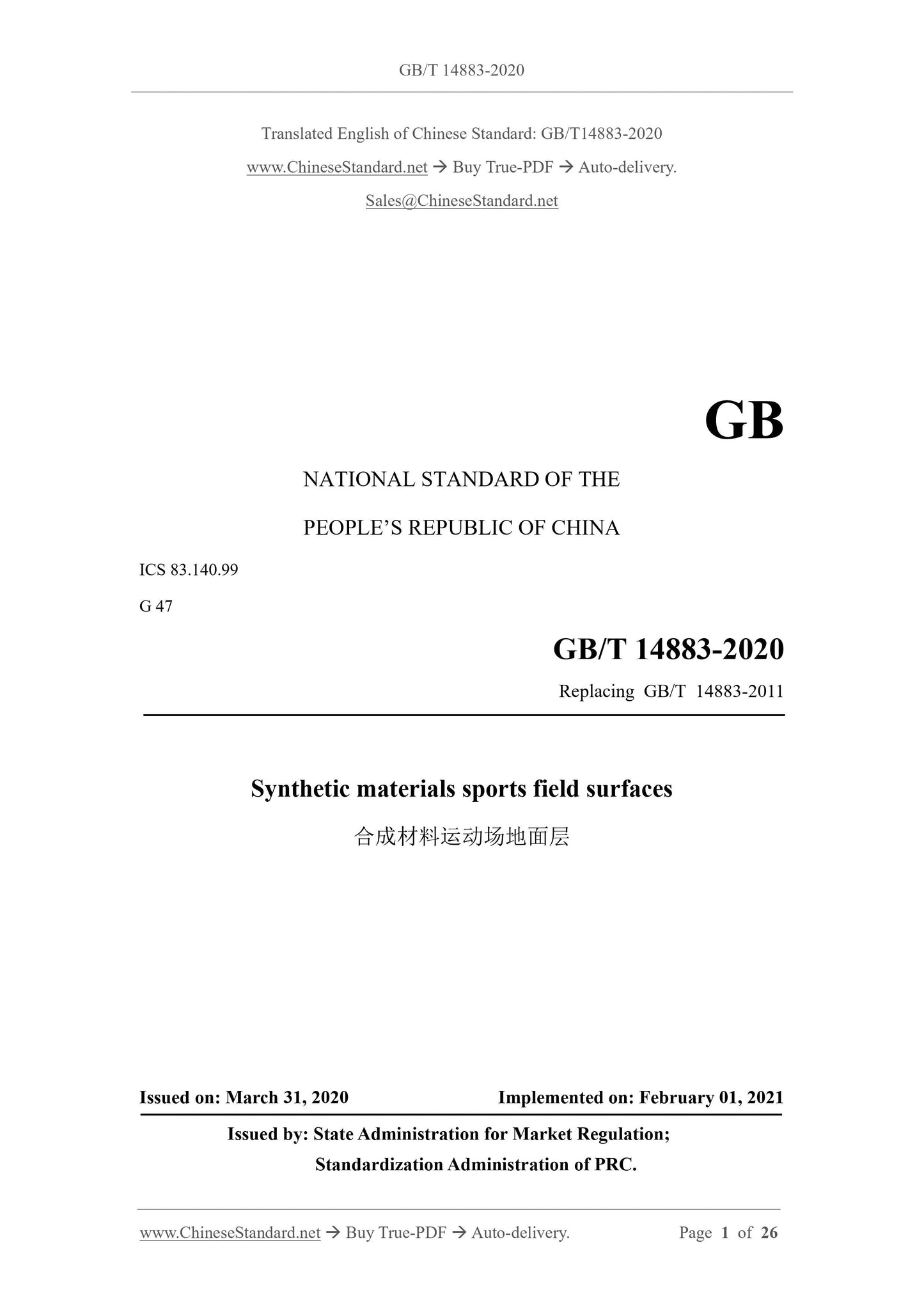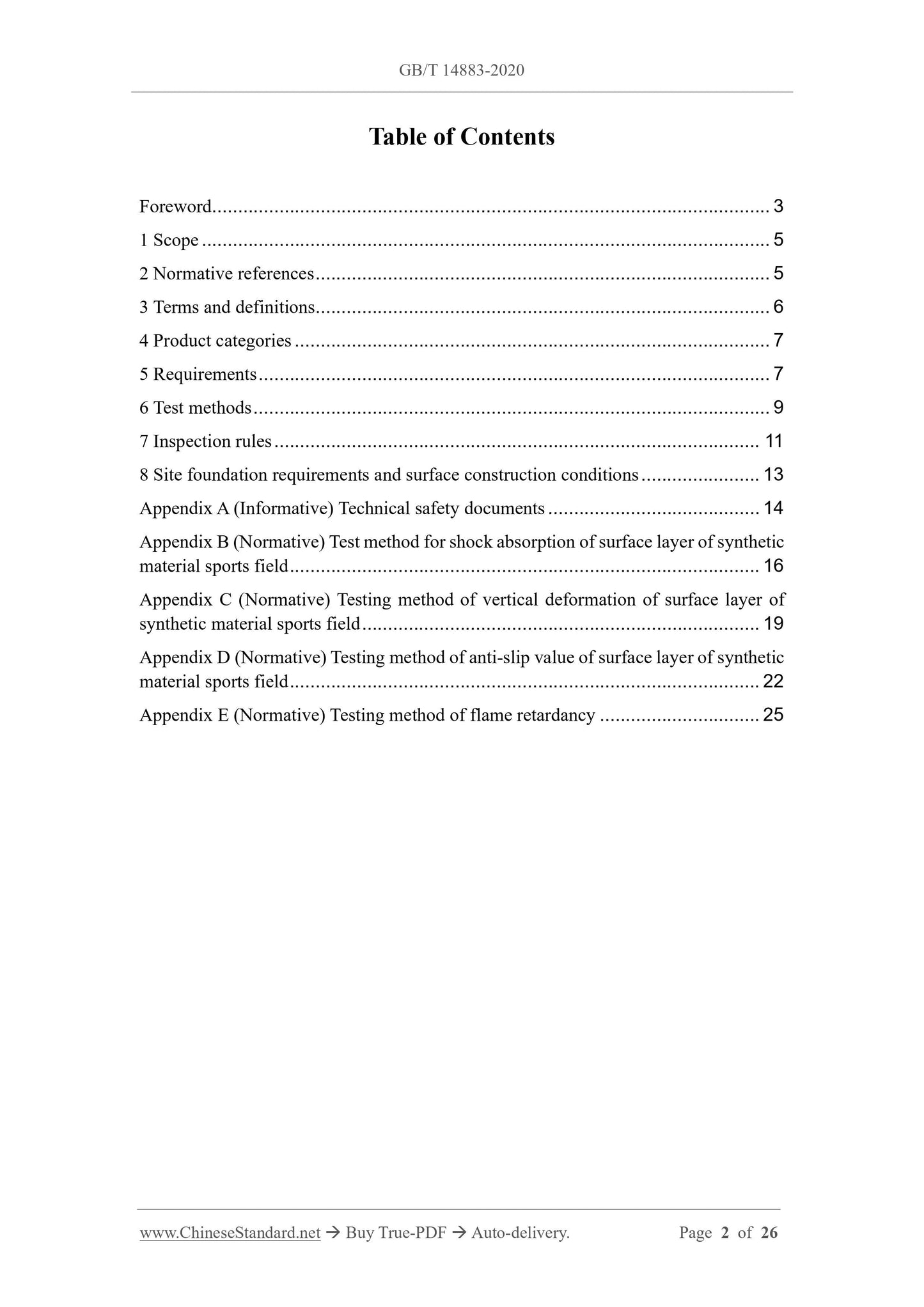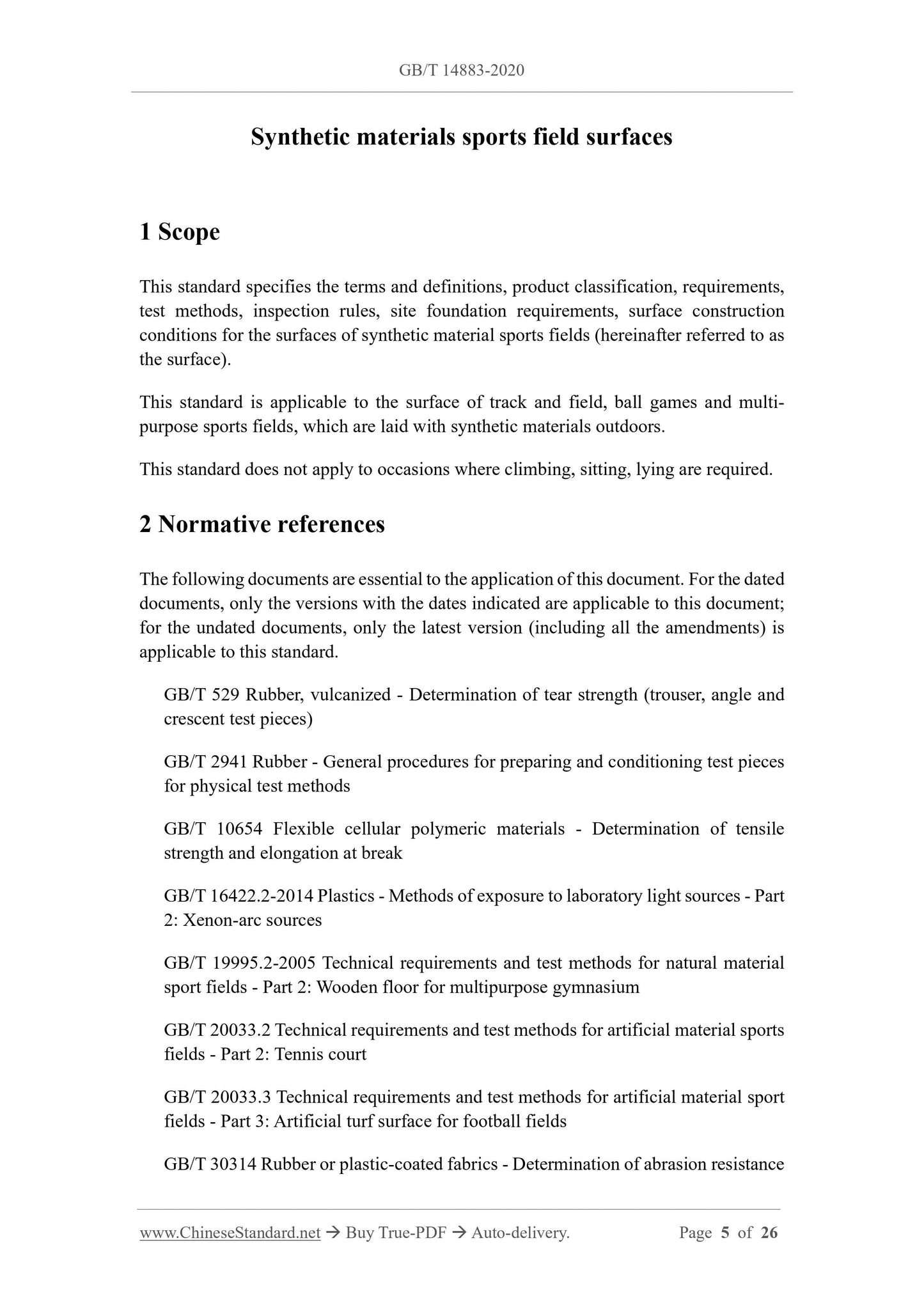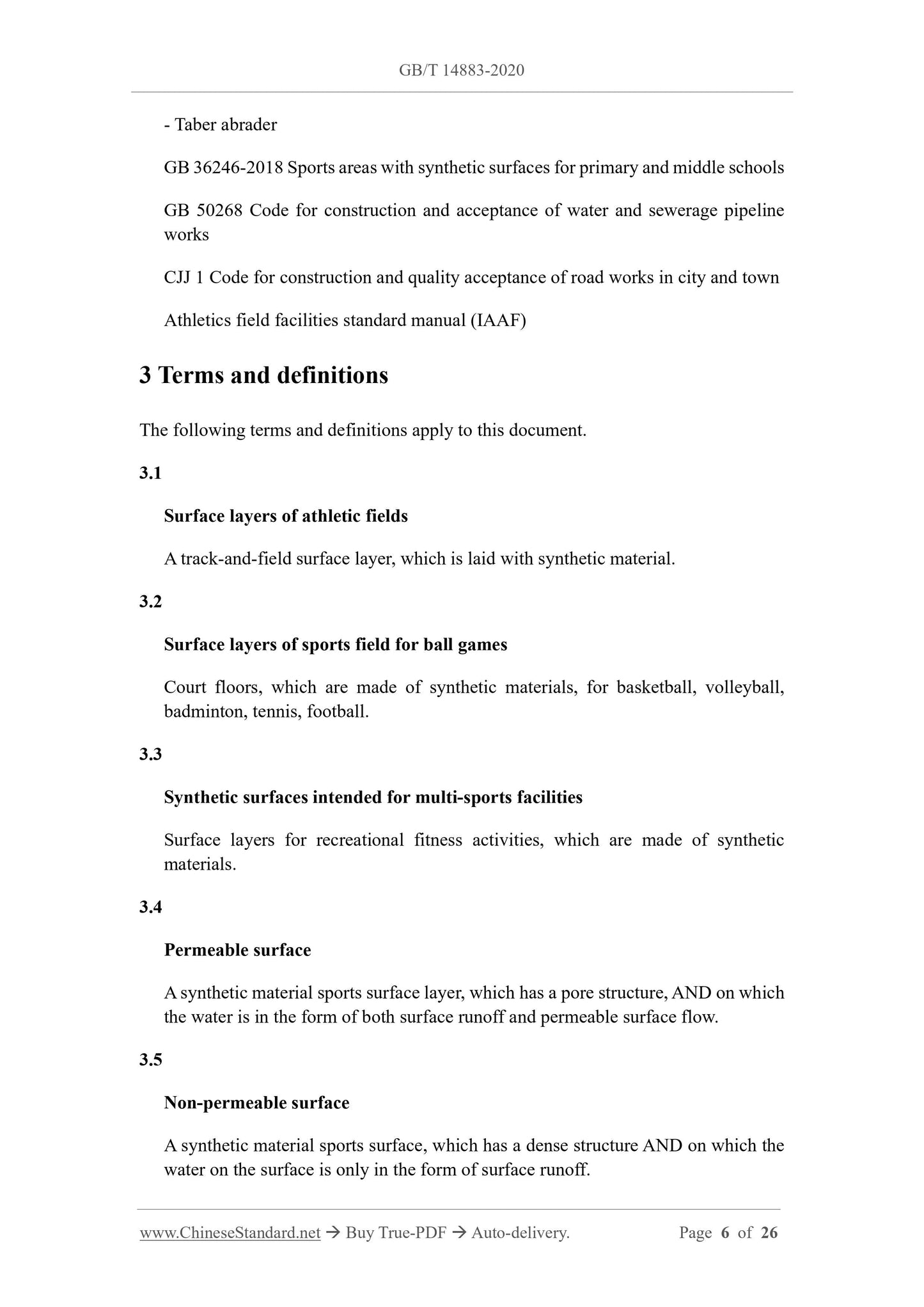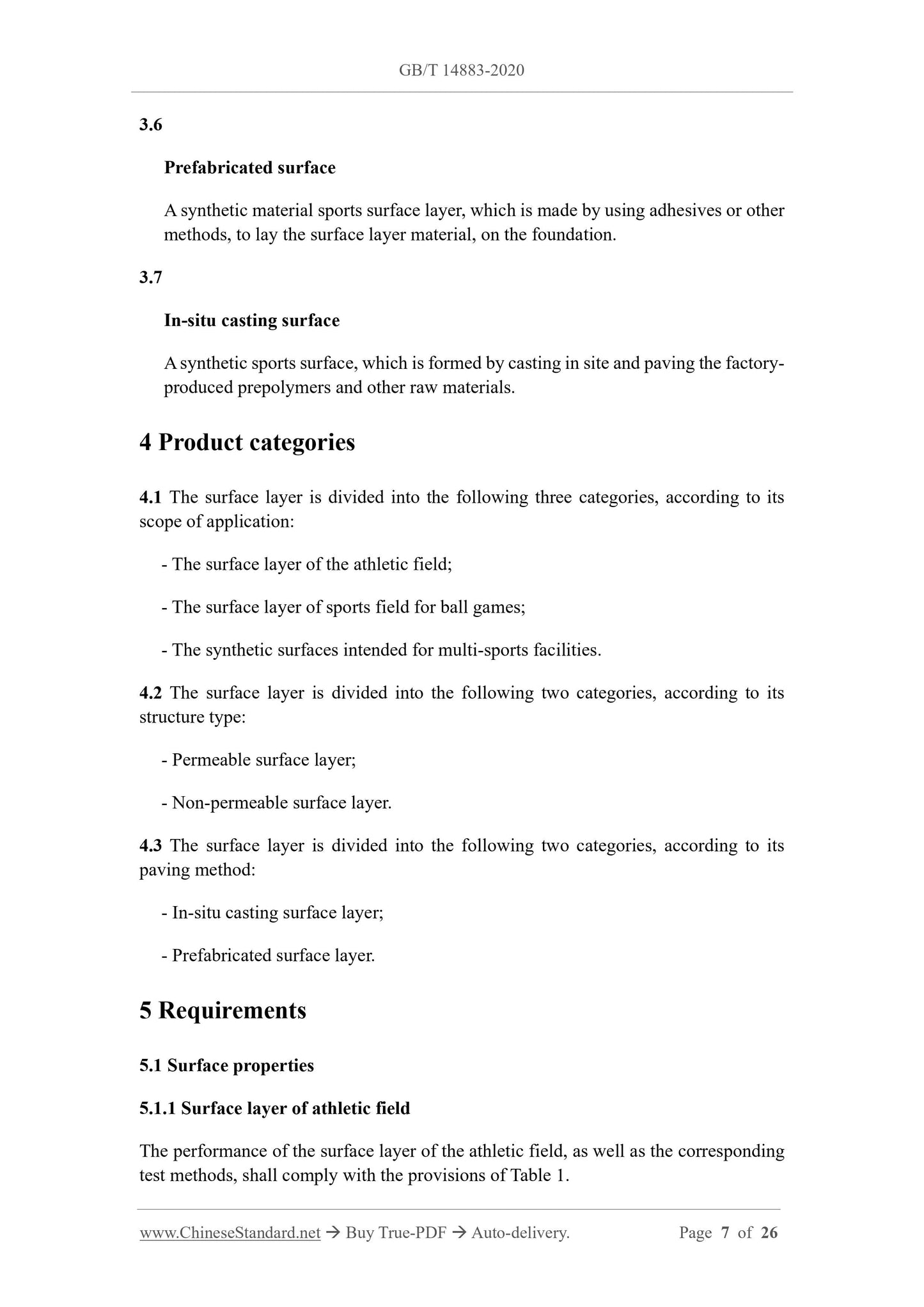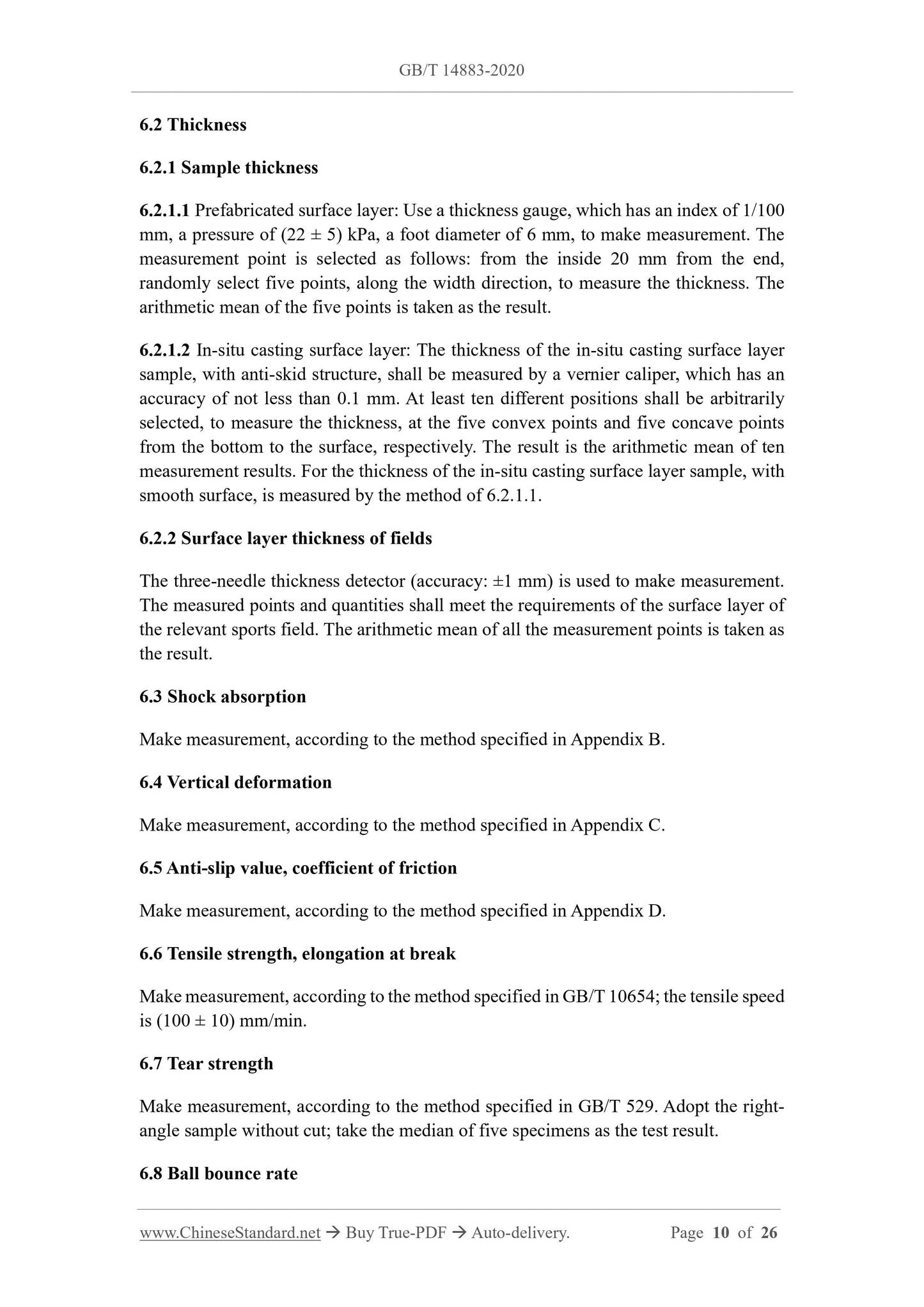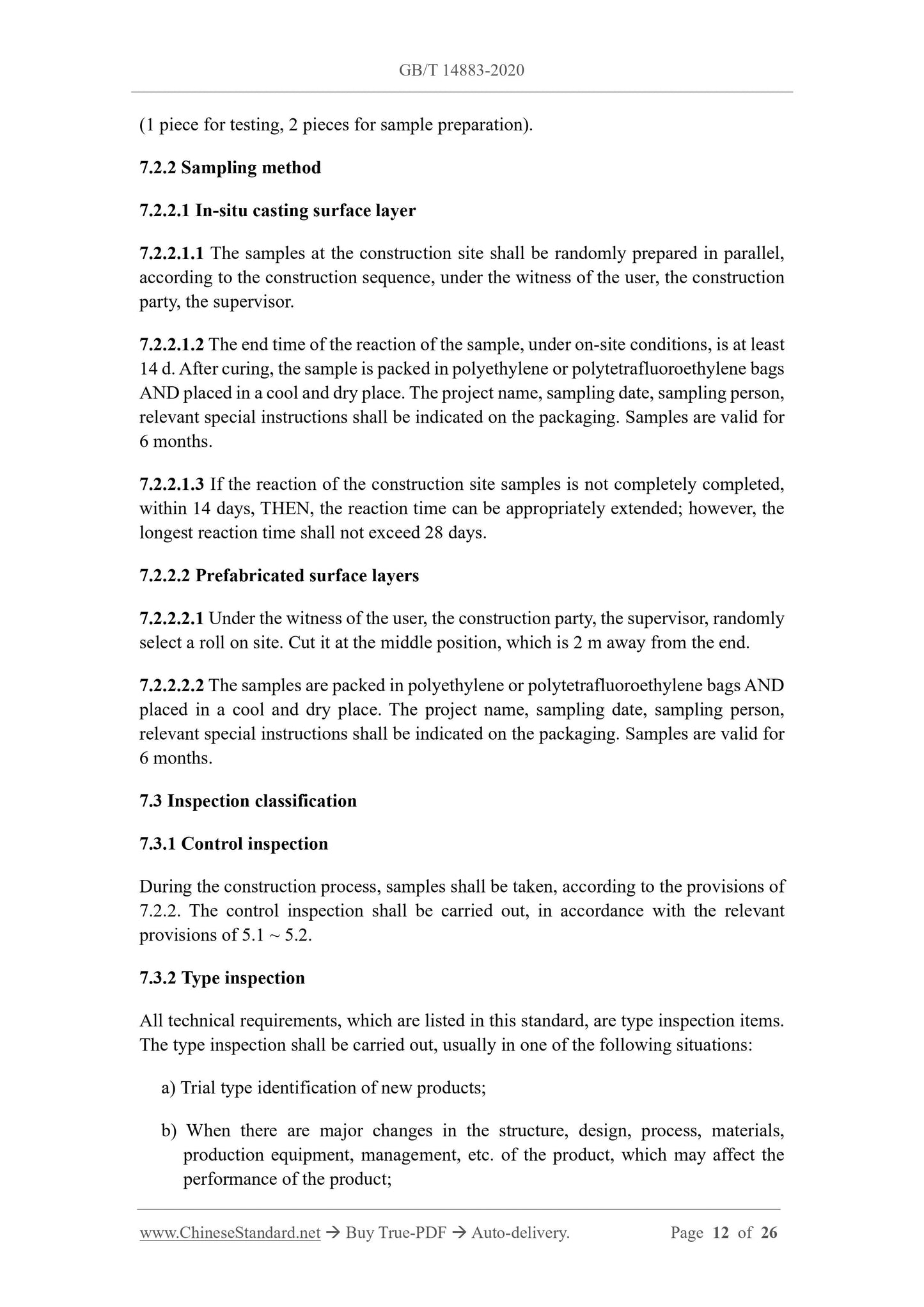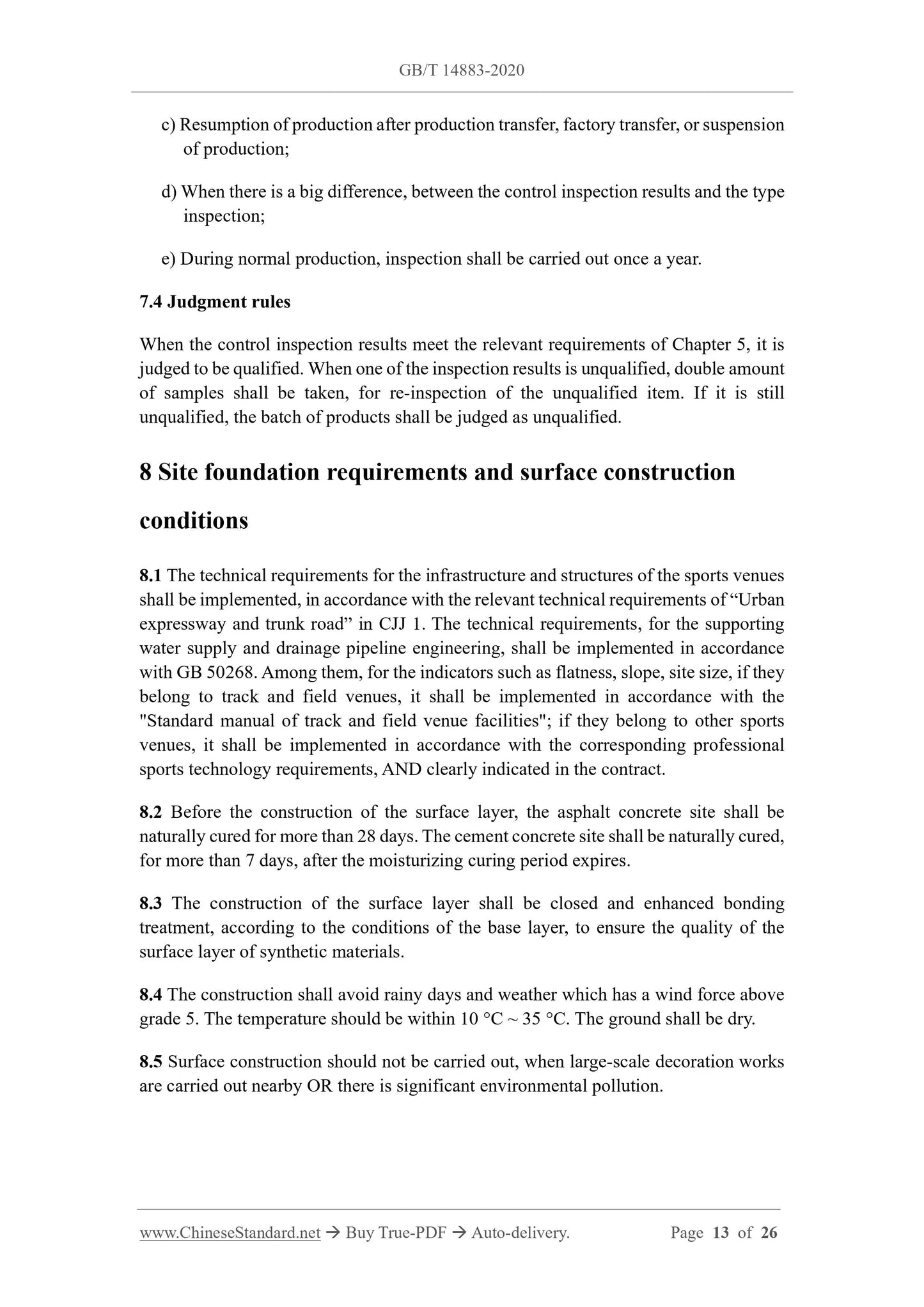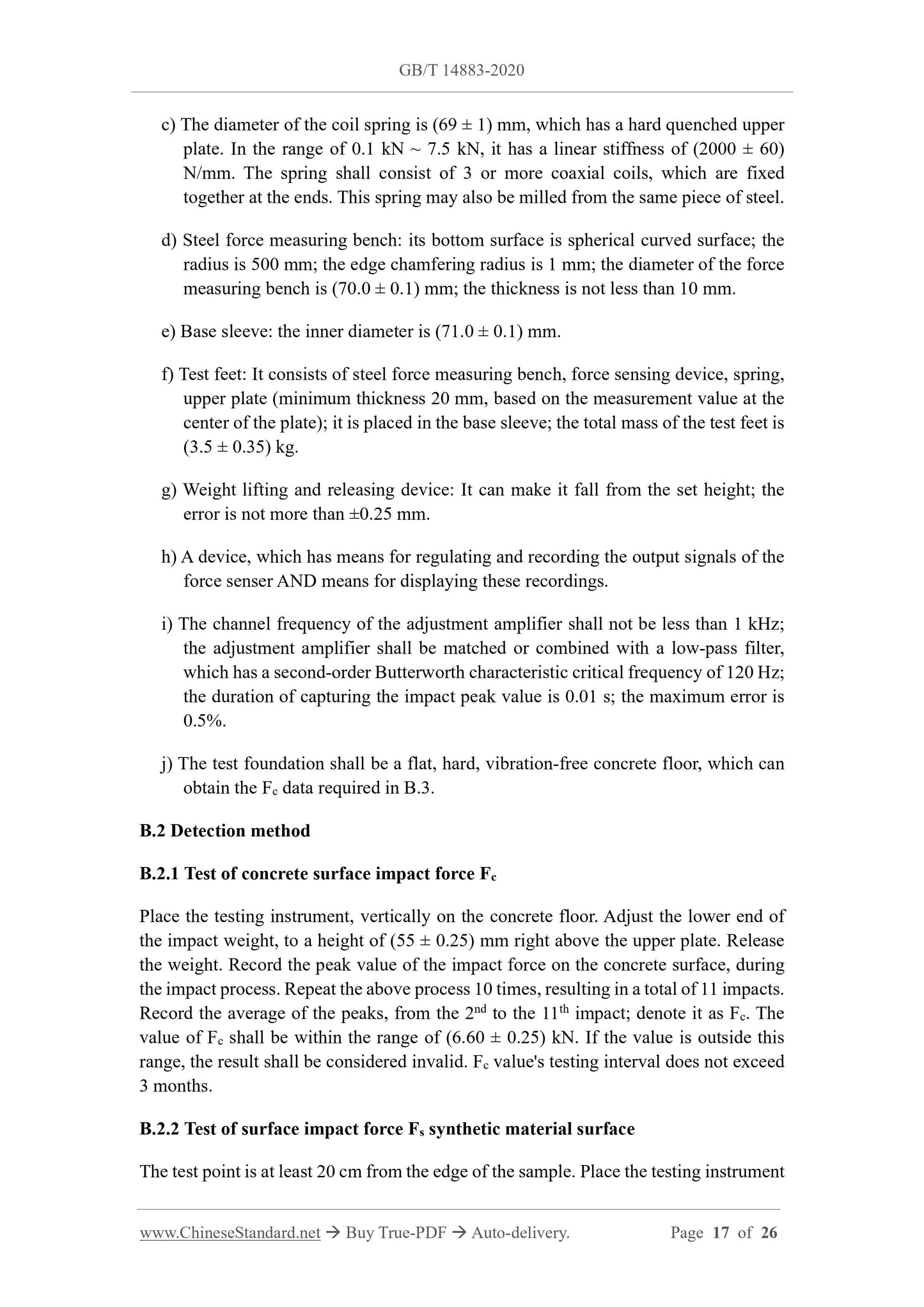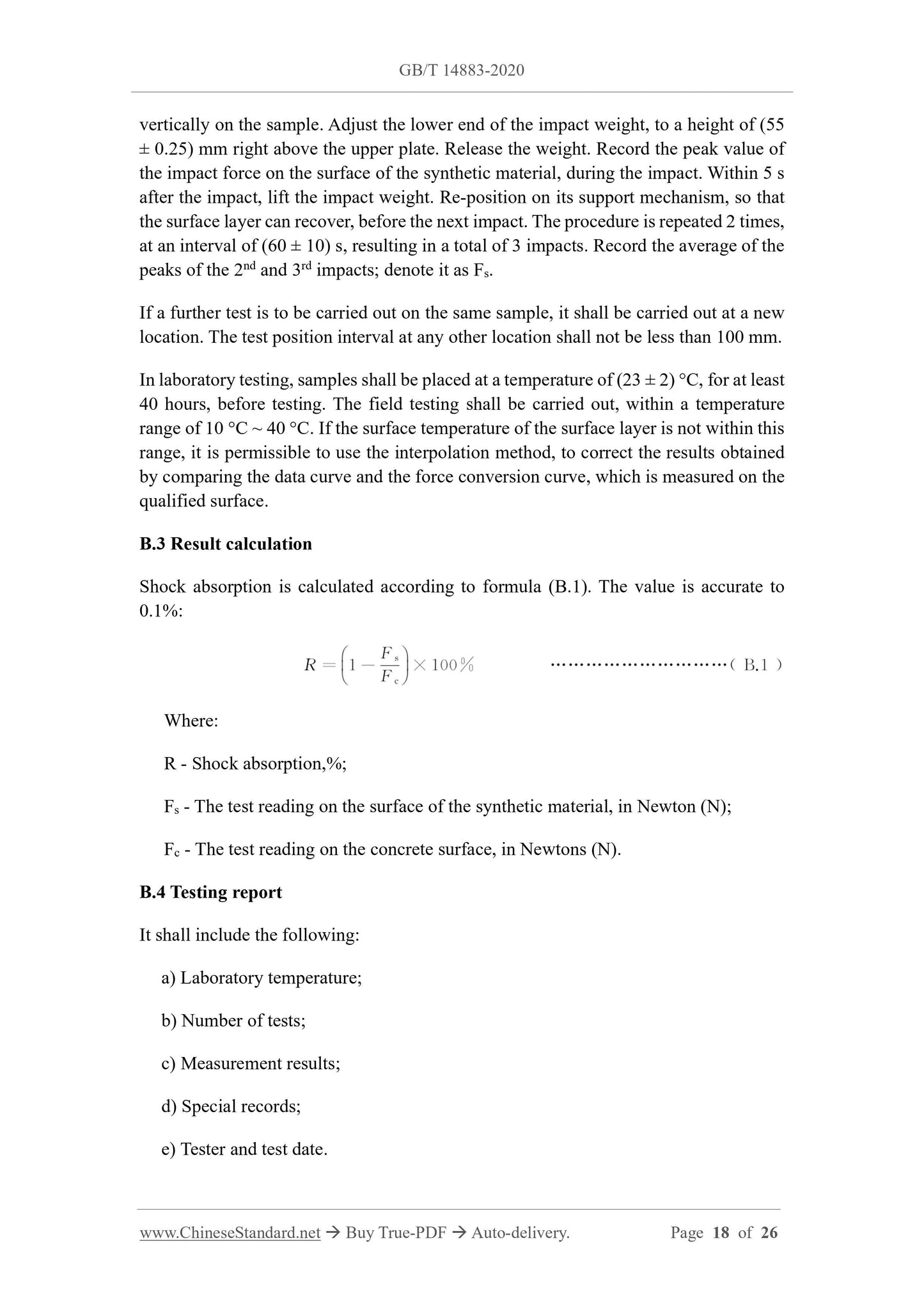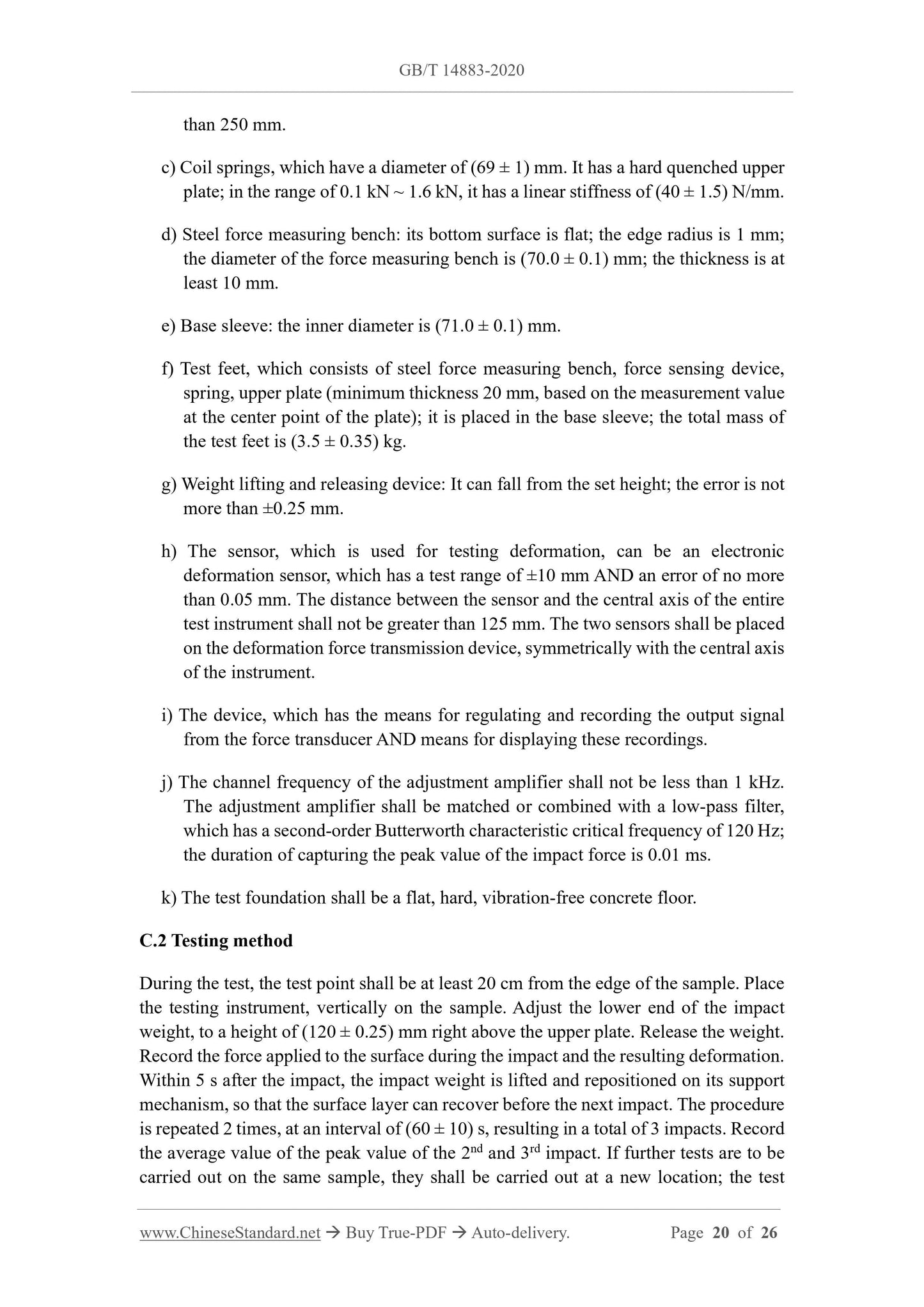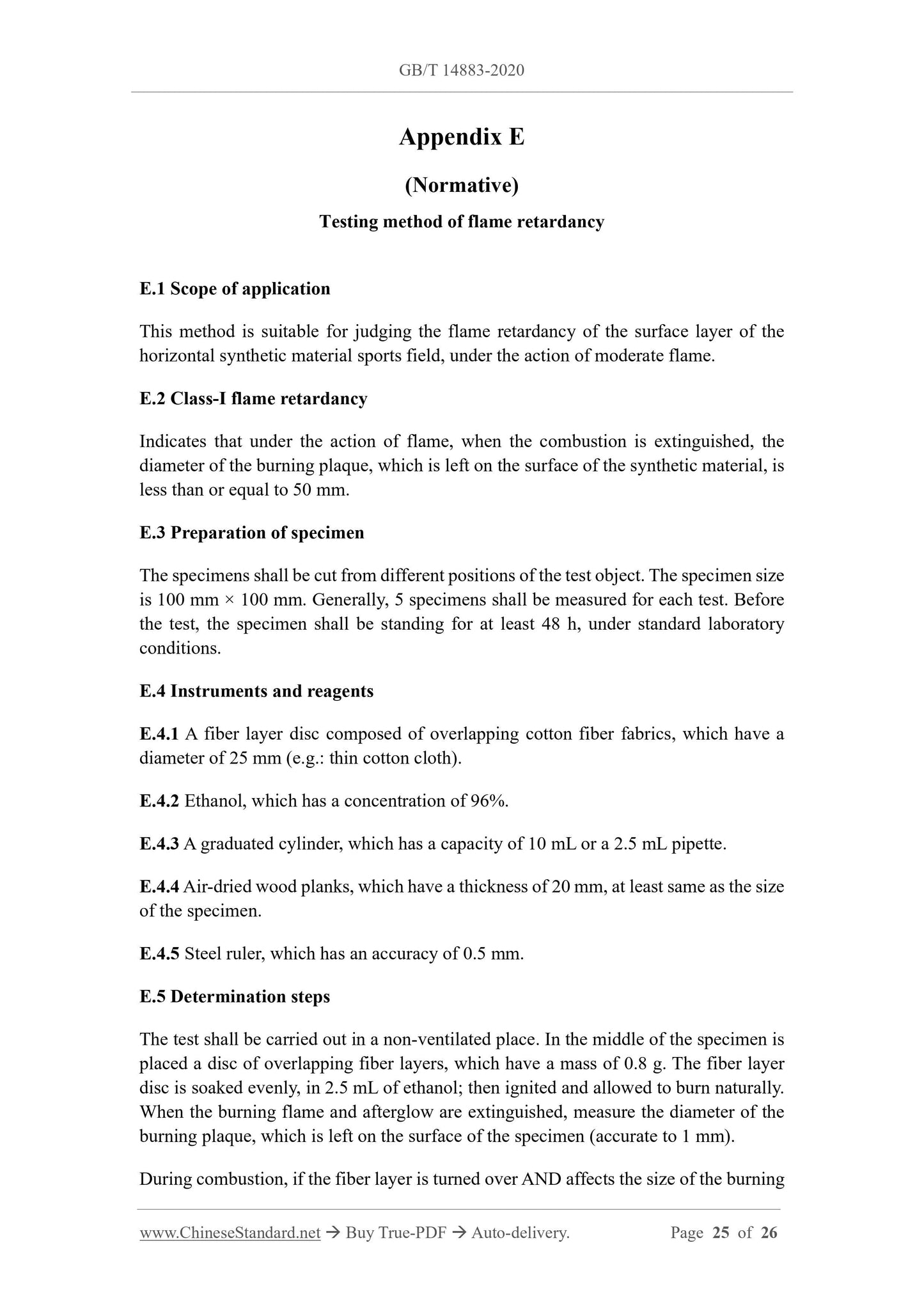1
/
of
12
PayPal, credit cards. Download editable-PDF and invoice in 1 second!
GB/T 14833-2020 English PDF (GBT14833-2020)
GB/T 14833-2020 English PDF (GBT14833-2020)
Regular price
$340.00 USD
Regular price
Sale price
$340.00 USD
Unit price
/
per
Shipping calculated at checkout.
Couldn't load pickup availability
Delivery: 3 seconds. Download true-PDF + Invoice.
Get Quotation: Click GB/T 14833-2020 (Self-service in 1-minute)
Historical versions (Master-website): GB/T 14833-2020
Preview True-PDF (Reload/Scroll-down if blank)
GB/T 14833-2020: Synthetic materials sports field surfaces
GB/T 14833-2020
Synthetic materials sports field surfaces
ICS 83.140.99
G47
National Standards of People's Republic of China
Replace GB/T 14833-2011
Synthetic sports ground floor
2020-03-31 release
2021-02-01 implementation
State Administration of Market Supervision and Administration
Issued by the National Standardization Management Committee
Foreword
This standard was drafted in accordance with the rules given in GB/T 1.1-2009.
This standard replaces GB/T 14833-2011 "Synthetic Material Runway Surface", compared with GB/T 14833-2011, except for editorial changes
In addition, the main technical changes are as follows.
--- Modified the standard name;
--- Modified the scope of application of the standard (see Chapter 1, Chapter 1 of the.2011 edition);
--- Modified the product classification (see Chapter 4, Chapter 3 of the.2011 edition);
--- Increased the technical performance requirements of the ground layer of balls and multi-function sports fields (see 5.1.2, 5.1.3);
--- Revised the requirements for the limits of harmful substances in surface materials (see 5.2, 4.2.2 of the.2011 edition);
--- Modified the test method (see Chapter 6, Appendix B, Appendix C, Chapter 5, Appendix A, Appendix B of the.2011 edition);
--- revised inspection rules (see Chapter 7, Chapter 6 of the.2011 edition);
--- Added site foundation requirements and surface construction conditions (see Chapter 8).
This standard was proposed by the China Petroleum and Chemical Industry Federation.
This standard is under the jurisdiction of the National Rubber and Rubber Products Standardization Technical Committee (SAC/TC35).
This standard was drafted by. Hangzhou Shunfan Sports Development Co., Ltd., Baoding Great Wall Synthetic Rubber Co., Ltd., Guangzhou Dayang Yuanheng Chemical Co., Ltd.
Limited company, Baoding Chaoda Sports Facilities Co., Ltd., Shandong Yinuowei Polyurethane Co., Ltd., Lianyungang Dexiang New Material Co., Ltd.,
Construction of Jiangsu Changnuo Sports Ground New Material Co., Ltd., Wuhan Institute of Physical Education, Guozheng Inspection and Certification Co., Ltd., and sports facilities in Zhejiang Province
Industry Association, Suzhou Xiangyuan New Material Co., Ltd., Hangzhou Sijia Construction Engineering Co., Ltd., Shandong Donghai Group Co., Ltd., Guangzhou He
Materials Research Institute Co., Ltd.
The main drafters of this standard. Zhou Jinpeng, Wang Wei, Shi Jianhua, Yuan Baoqing, Sun Qingfeng, Chen Chao, Shen Zujian, Zheng Weitao, Zhou Licheng, Fu Chengjun,
Zhou Jian, Shao Jianhua, Pan Chaoyang, Yi Jun.
The previous versions of the standard replaced by this standard are as follows.
--- GB/T 14833-1993, GB/T 14833-2011.
Synthetic sports ground floor
1 Scope
This standard specifies the terms and definitions, product classifications, requirements, test methods, and inspections for the ground layer of synthetic material sports ground (hereinafter referred to as surface layer)
Inspection rules, site foundation requirements and surface construction conditions.
This standard applies to track and field, ball and multi-functional sports grounds laid outdoors by synthetic materials.
This standard does not apply to the occasion of climbing sitting and lying needs.
2 Normative references
The following documents are essential for the application of this document. For dated references, only the dated version applies to this article
Pieces. For the cited documents without date, the latest version (including all amendments) applies to this document.
GB/T 529 Determination of tear strength of vulcanized rubber or thermoplastic rubber (pants-shaped, right-angled and crescent shaped specimens)
GB/T 2941 Rubber physical test method General procedure for sample preparation and adjustment
GB/T 10654 Determination of tensile strength and elongation at break of porous elastic materials
GB/T 16422.2-2014 Plastic laboratory light source exposure test method Part 2. Xenon arc lamp
GB/T 19995.2-2005 Use requirements and inspection methods of natural materials sports venues Part 2. Wooden floors for integrated sports venues
site
GB/T 20033.2 Requirements and inspection methods for artificial materials sports venues Part 2. Tennis courts
GB/T 20033.3 Requirements and test methods for artificial materials sports venues Part 3. Artificial grass surface layer for football field
GB/T 30314 Determination of wear resistance of rubber or plastic coated fabrics Taber method
GB 36246-2018 Primary and middle school synthetic material surface sports field
GB 50268 Code for Construction and Acceptance of Water Supply and Drainage Pipeline Engineering
CJJ1 Code for Construction and Quality Acceptance of Urban Road Engineering
Track and Field Facilities Standards Manual (IAAF)
3 Terms and definitions
The following terms and definitions apply to this document.
3.1
Track and field ground layer surfacelayersofathleticfields
The ground layer of synthetic materials for track and field.
3.2
Ball sports ground layer surfacelayersofsportsfieldforbalgames
The ground layer of the basketball court, volleyball, badminton, tennis, and football that is made of synthetic materials.
3.3
Multifunctional sports ground floor synthetic surface integrated for multi-sports facilities
The ground floor of the field used for leisure and fitness exercise laid by synthetic materials.
3.4
Permeable surface
It has a pore structure. In addition to the surface runoff, there is also a moving surface layer of synthetic material in the form of permeable surface layer flow.
Get Quotation: Click GB/T 14833-2020 (Self-service in 1-minute)
Historical versions (Master-website): GB/T 14833-2020
Preview True-PDF (Reload/Scroll-down if blank)
GB/T 14833-2020: Synthetic materials sports field surfaces
GB/T 14833-2020
Synthetic materials sports field surfaces
ICS 83.140.99
G47
National Standards of People's Republic of China
Replace GB/T 14833-2011
Synthetic sports ground floor
2020-03-31 release
2021-02-01 implementation
State Administration of Market Supervision and Administration
Issued by the National Standardization Management Committee
Foreword
This standard was drafted in accordance with the rules given in GB/T 1.1-2009.
This standard replaces GB/T 14833-2011 "Synthetic Material Runway Surface", compared with GB/T 14833-2011, except for editorial changes
In addition, the main technical changes are as follows.
--- Modified the standard name;
--- Modified the scope of application of the standard (see Chapter 1, Chapter 1 of the.2011 edition);
--- Modified the product classification (see Chapter 4, Chapter 3 of the.2011 edition);
--- Increased the technical performance requirements of the ground layer of balls and multi-function sports fields (see 5.1.2, 5.1.3);
--- Revised the requirements for the limits of harmful substances in surface materials (see 5.2, 4.2.2 of the.2011 edition);
--- Modified the test method (see Chapter 6, Appendix B, Appendix C, Chapter 5, Appendix A, Appendix B of the.2011 edition);
--- revised inspection rules (see Chapter 7, Chapter 6 of the.2011 edition);
--- Added site foundation requirements and surface construction conditions (see Chapter 8).
This standard was proposed by the China Petroleum and Chemical Industry Federation.
This standard is under the jurisdiction of the National Rubber and Rubber Products Standardization Technical Committee (SAC/TC35).
This standard was drafted by. Hangzhou Shunfan Sports Development Co., Ltd., Baoding Great Wall Synthetic Rubber Co., Ltd., Guangzhou Dayang Yuanheng Chemical Co., Ltd.
Limited company, Baoding Chaoda Sports Facilities Co., Ltd., Shandong Yinuowei Polyurethane Co., Ltd., Lianyungang Dexiang New Material Co., Ltd.,
Construction of Jiangsu Changnuo Sports Ground New Material Co., Ltd., Wuhan Institute of Physical Education, Guozheng Inspection and Certification Co., Ltd., and sports facilities in Zhejiang Province
Industry Association, Suzhou Xiangyuan New Material Co., Ltd., Hangzhou Sijia Construction Engineering Co., Ltd., Shandong Donghai Group Co., Ltd., Guangzhou He
Materials Research Institute Co., Ltd.
The main drafters of this standard. Zhou Jinpeng, Wang Wei, Shi Jianhua, Yuan Baoqing, Sun Qingfeng, Chen Chao, Shen Zujian, Zheng Weitao, Zhou Licheng, Fu Chengjun,
Zhou Jian, Shao Jianhua, Pan Chaoyang, Yi Jun.
The previous versions of the standard replaced by this standard are as follows.
--- GB/T 14833-1993, GB/T 14833-2011.
Synthetic sports ground floor
1 Scope
This standard specifies the terms and definitions, product classifications, requirements, test methods, and inspections for the ground layer of synthetic material sports ground (hereinafter referred to as surface layer)
Inspection rules, site foundation requirements and surface construction conditions.
This standard applies to track and field, ball and multi-functional sports grounds laid outdoors by synthetic materials.
This standard does not apply to the occasion of climbing sitting and lying needs.
2 Normative references
The following documents are essential for the application of this document. For dated references, only the dated version applies to this article
Pieces. For the cited documents without date, the latest version (including all amendments) applies to this document.
GB/T 529 Determination of tear strength of vulcanized rubber or thermoplastic rubber (pants-shaped, right-angled and crescent shaped specimens)
GB/T 2941 Rubber physical test method General procedure for sample preparation and adjustment
GB/T 10654 Determination of tensile strength and elongation at break of porous elastic materials
GB/T 16422.2-2014 Plastic laboratory light source exposure test method Part 2. Xenon arc lamp
GB/T 19995.2-2005 Use requirements and inspection methods of natural materials sports venues Part 2. Wooden floors for integrated sports venues
site
GB/T 20033.2 Requirements and inspection methods for artificial materials sports venues Part 2. Tennis courts
GB/T 20033.3 Requirements and test methods for artificial materials sports venues Part 3. Artificial grass surface layer for football field
GB/T 30314 Determination of wear resistance of rubber or plastic coated fabrics Taber method
GB 36246-2018 Primary and middle school synthetic material surface sports field
GB 50268 Code for Construction and Acceptance of Water Supply and Drainage Pipeline Engineering
CJJ1 Code for Construction and Quality Acceptance of Urban Road Engineering
Track and Field Facilities Standards Manual (IAAF)
3 Terms and definitions
The following terms and definitions apply to this document.
3.1
Track and field ground layer surfacelayersofathleticfields
The ground layer of synthetic materials for track and field.
3.2
Ball sports ground layer surfacelayersofsportsfieldforbalgames
The ground layer of the basketball court, volleyball, badminton, tennis, and football that is made of synthetic materials.
3.3
Multifunctional sports ground floor synthetic surface integrated for multi-sports facilities
The ground floor of the field used for leisure and fitness exercise laid by synthetic materials.
3.4
Permeable surface
It has a pore structure. In addition to the surface runoff, there is also a moving surface layer of synthetic material in the form of permeable surface layer flow.
Share
